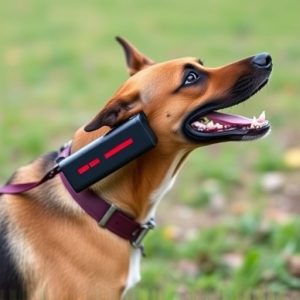Dog Deterrent Spray Range: Effectiveness & Safety Guide for Pets
Dog deterrent spray, using capsaicin from chili peppers, irritates dogs' noses and keeps them a…….
Dog deterrent spray, using capsaicin from chili peppers, irritates dogs' noses and keeps them away from treated areas. Effective range varies based on sprayer size, solution type, environmental conditions, and terrain. Apply along fences at 4-6 feet distances every 2-3 weeks. In case of exposure, flush skin/eyes with water for 15 minutes or move affected person to fresh air if inhaled; keep sprays away from children and pets. For severe reactions or emergency care involving masked animals, contact local veterinary services immediately.
“Uncover the power of dog deterrent spray—a non-lethal tool for managing canine behavior. This comprehensive guide explores its effectiveness, ranging from 10 to 30 feet, depending on factors like spray type and environmental conditions. Learn how to maximize its impact through proper application techniques. Additionally, we delve into safety precautions and emergency care steps should your pets or other animals mistakenly come into contact with the spray. Ensure you’re prepared to handle any incidents with our expert advice on Emergency Care for Maced Animals.”
- Understanding Dog Deterrent Spray: What It Is and How It Works
- Factors Affecting the Effective Range of Dog Deterrent Spray
- Application Techniques for Optimal Results: A Step-by-Step Guide
- Safety Precautions and Emergency Care for Mistaken Exposure to Dog Deterrent Spray
Understanding Dog Deterrent Spray: What It Is and How It Works
Dog deterrent spray, also known as dog repellent or anti-dog spray, is a powerful tool designed to protect against unwanted canine encounters. This innovative product is specifically formulated to create an effective barrier between pets and potential threats, offering both immediate and long-term solutions for emergency care of maced animals.
The spray works by emitting a strong scent that dogs find unpleasant, causing them to avoid the treated area. Key ingredients in these sprays often include capsaicin, a compound found in chili peppers, which is safe for humans but irritates dog’s sensitive olfactory system. When sprayed, it creates an area of protection, giving pet owners and professionals valuable time to manage and prevent potential attacks or disturbances. Understanding how it works is crucial in utilizing emergency care for maced animals effectively and ensuring the safety of both pets and individuals in various environments.
Factors Affecting the Effective Range of Dog Deterrent Spray
The effective range of dog deterrent spray can vary greatly depending on several factors, which are crucial to understanding its optimal use in emergency care for masked animals. First and foremost, the size and strength of the sprayer itself play a significant role. Larger, industrial-grade sprayers will generally have a longer reach compared to smaller, handheld models. Additionally, the type of solution being sprayed matters; some formulations project a finer mist over a broader area, while others emit a stronger, more concentrated stream, each with its own effective range.
Environmental conditions also greatly affect the spray’s range. Wind direction and speed can quickly disperse or direct the spray away from its intended target. Weather conditions like rain or humidity can impact the spray’s longevity and effectiveness. Furthermore, the terrain and surroundings can influence how far the spray travels; spraying up a hill or in dense foliage may result in reduced range compared to open, flat areas.
Application Techniques for Optimal Results: A Step-by-Step Guide
For optimal results with dog deterrent spray, understanding and implementing the right application techniques is crucial. Begin by identifying the problem areas where dogs frequently trespass or exhibit unwanted behavior. Spray along fences, walls, or other barriers, ensuring even coverage of the target zone. A distance of 4-6 feet from the boundary is ideal for most deterrents to ensure effectiveness without causing harm. Use a spray motion that creates a fine mist, allowing the solution to settle evenly on surfaces.
Regular application is key; repeat every 2-3 weeks or as needed, especially during shedding seasons. In emergency care for maced animals, always follow local regulations and consult professionals before use. Be mindful of wind direction to avoid blowing the spray back onto your property or nearby areas. Test the solution in a small, controlled area first to ensure it doesn’t harm plants or cause environmental issues.
Safety Precautions and Emergency Care for Mistaken Exposure to Dog Deterrent Spray
In the event of accidental exposure to dog deterrent spray, immediate safety precautions are crucial. If the spray comes into contact with skin or eyes, flush thoroughly with water for at least 15 minutes. For inhalation, move the affected individual to fresh air and seek medical attention if symptoms persist. It’s important to keep dog deterrent sprays out of reach of children and pets to prevent accidental exposure.
In cases of severe reaction or emergency care for masked animals, contact local veterinary services immediately. They can provide specific guidance based on the type of spray and its active ingredients. Have the product label handy to share essential information with medical professionals. Quick action is key in ensuring positive outcomes for both humans and animals affected by dog deterrent spray.
Dog deterrent spray can be an effective tool for managing canine behavior, but understanding its range and proper application is key. By considering environmental factors and using appropriate techniques, you can maximize its efficacy. Remember, safety precautions are vital, especially in emergency situations involving accidental exposure to the spray. Knowing how to provide immediate care for affected animals can make a significant difference in their well-being. Always be mindful of local regulations and consult professionals when needed to ensure safe and responsible use of dog deterrent sprays.


